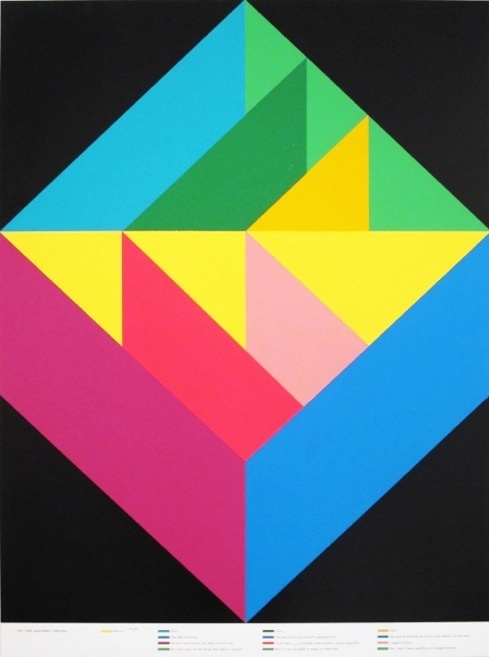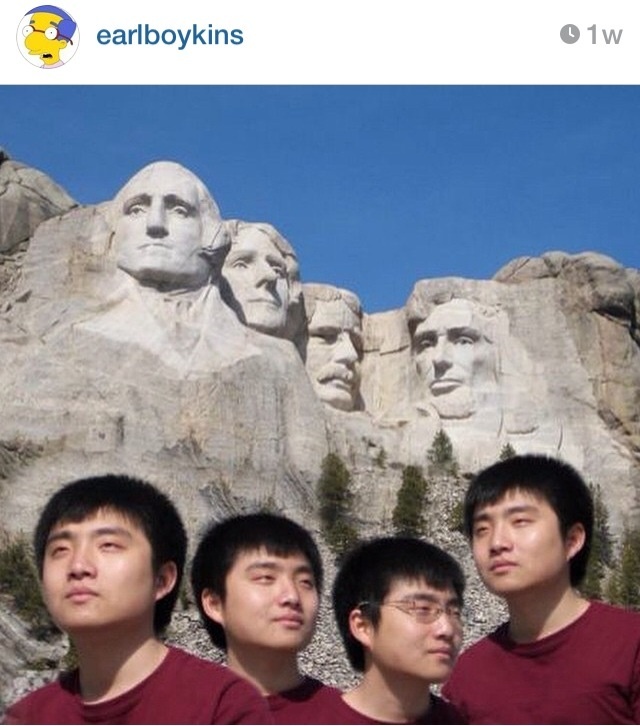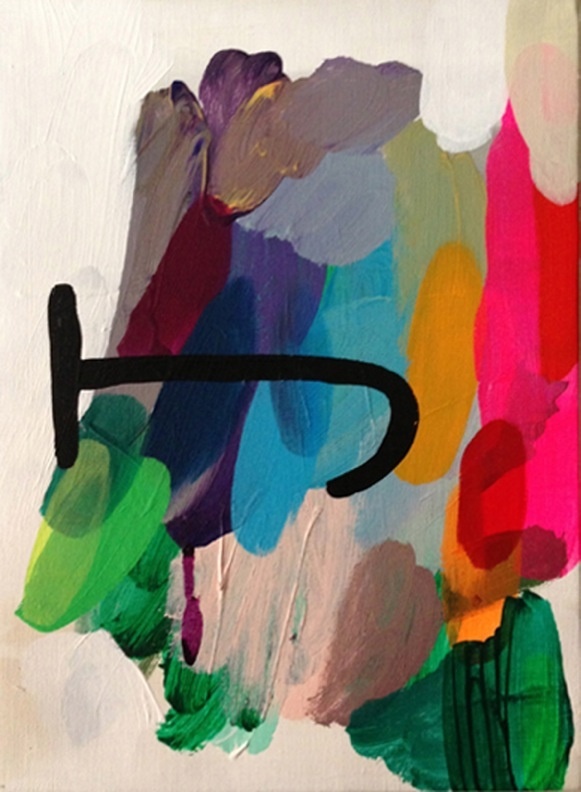Andrew Kuo, Tallboy, 2012. Acrylic On Linen. 20 X 16 Inches
Andrew Kuo has been one of my favorite contemporary artists for the past few years, ever since I first noticed his intricate music-centered charts in the New York Times. Whether he’s creating geometric graphs, portraits, paintings of bodega flowers, or just posting funny cat pictures on his incredibly popular Instagram account, his work is entertaining, funny, often poignant, and always visually appealing. This Thursday, Kuo will speak at NeueHouse with iconic photographer Ari Marcopoulos in a conversation about art and sports, moderated by New Yorker contributor Kelefa Sanneh. I spoke to him on the phone to find out more about the talk, sports fandom, his artistic process, and what he’s been listening to lately.
Videos by VICE

Andrew Kuo, Good Talk (3/16/14), 2014 Acrylic And Carbon Transfer On Panel And Laminated Paper
The Creators Project: I guess I should start off by admitting that I’m not much of a sports fan. I’ve tried, but I just can’t get into them.
Andrew Kuo: I don’t blame you, you’re better off for it.
No, I mean I really would like to get into them! The flyer for the Art + Sports talk with Ari Marcopoulos and Kelefa Sanneh mentions that it’s to “celebrate the start of the Knicks’ season.” Is it safe to assume it’ll be pretty heavily focused on the Knicks?
Uh, a little bit, I hope not too much, but that’s what me and Ari have in common. There’ll be a lot about the Knicks and a lot about how we think about sports in general.
Well, how do you think about sports in general?
Well, there’s a whole universe that is out there. I guess what I’m interested in is the analytical part. And the part that deals with numbers and rules and rule changes and ways to rethink numbers. It’s been a pretty interesting last twenty years of sports analytics because of technology and the way they record things on the field, so I’m really interested in that whole discussion.

Andrew Kuo, The Same Song on 3/5/13 Detail, 2013. Acrylic And Carbon Transfer On Panel And Laminated Paper. 51 X 38 Inches
There’s always been really smart people who care about sports but it seems like in recent years there have been more prominent, serious writers grappling with sports, like with Grantland or the Classical. I’m wondering if you feel like sports have gotten a bit more intellectual attention recently?
That’s hard to tell. Personally I feel like sports have always been kind of a subject of interest for nerds. You always have these politicians and writers who, in one way or another are obsessed with something like baseball or basketball. I think through the visibility of the internet we just get more of everything. But I’m not really sure if it appeals to more people now than it previously did. Perhaps, but, I would say it was a pretty big deal also in the 80s and early 90s. Like it’s hard for me to prove that it’s actually bigger.
Beyond Jeff Koons’s basketball (and your Jeremy Lin painting referencing it), I haven’t seen a lot of modern sports in fine art. Am I just missing it?
No, I do think you have a point there. I mean, you can point to examples where it exists. For example, Raymond Pettibon is really obsessed with surfing and baseball. There are a lot of artists who have done things but it’s not very prevalent. If I had to take a guess it would be maybe its a generational thing. You know, sports and art didn’t really co-exist in the generation previous to mine. Maybe because of the accessibility of data and analytics, it’s more fun for someone like me who played sports in high school but obviously did not excel at sports in high school.
The way sports are shown on TV now, which started probably in the late 90s with cable, means we can get access to anything we want game-wise. It became less of a regional thing and more of a world thing and I think that helped a lot too. Maybe we’ll see more sports in artwork after it kind of feeds itself through.
I’m assuming you’re watching the World Series?
Yeah, like everyone outside of San Francisco should be, I’m rooting for the Royals. They’re more colorful and fun and the Giants seem to be more straightforward and they’ve won a lot. I think everyone is pulling for the Royals.

Andrew Kuo, The Time Machine’s Broken, 2013
I know you’re a Knicks fan. I feel like the Knicks are one of those teams that are associated with repeatedly breaking their fans’ hearts.
Oh yeah. Ten years ago, I would’ve said that they have made my life worse. They’ve kind of been a disaster my whole life. We had some good moments in the late 90s for sure—the last good moment was in 1999 when we made the final—but that was a long time ago, fourteen years at this point.
But now, in 2014 I would say I get only positive feelings about the Knicks. Maybe when I was younger, winning mattered to me more, and now that I’m older, the process matters to me more, and the things that happen before you win. I don’t really care who wins a game but I care about everything that happens during a game, if that makes sense. I’d be happy if they won, of course, but I don’t know if I could love that team any more than I do now. There’s that whole group of teams like the Chicago Cubs or the Boston Red Sox who never won. And when the Red Sox won the World Series [in 2004, for the first time since 1918], some argued that the whole identity of that region changed, and they kind of lost their character a bit, you know? So I’m a happy Knicks fan in 2014.
Outside of the Knicks, what are your other teams?
In the 80s when I was a kid, I chose all the losing teams in New York. So that would be the Yankees and the Knicks, the Jets and the Rangers. But the Yankees are good now, which is annoying, but in the 80s they were just awful. And the Mets were great.
There seem to be a few different ways people come across your work. There’s your Instagram account, @earlboykins, and I’ve met people who just know that account and don’t realize there’s an artist behind it. Then there’s people who might know you through your charts in the New York Times. And then there’s your paintings. Do you feel a distinction between all of that?
Personally no, because I just feel like this is just my life and it’s all intertwined. I understand the distinction and I get where the intersection might not be as apparent, but I think it’s all the same. I think if you really got into it, in the way that I get into it because I have to make it, I think they all kind of talk to each other. Plus there’s also the music aspect of everything, like the DJing and the playing live, but I welcome it all kind of; it all kind of informs the paintings first and foremost but I try not to think about it too much.
You’re never like, “Oh, I haven’t done this side of things for a few days, I need to focus on that right now”?
Not particularly. Every day is painting pretty heavily. I have a pretty intensive studio routine. The Instagram is pretty easy, I can just do that on my phone as I’m waiting for paint to dry. The Times thing, I spend a few hours a week on something like that. I would say it’s like 80% studio work and 20% everything else in my life.

Regarding your Instagram account, do you ever get criticism from people that you’re just posting pictures from the internet?
Occasionally, I’ve had one or two people who have been like, “You’re not taking all of these pictures. How can you have been in daylight when it’s nighttime in New York?” I hope I make no bones about it, these are not my pictures. I love the internet, I love the who appropriation aspect of it, I love the images people put on it. I don’t even try and find deep cuts all the time, some of them I know you’ve seen before. I think that’s where it becomes interesting, it doesn’t necessarily become me telling you something you don’t know. Some of these images have definitely been circulating and I think it’s fun for me to look at the object as a whole: a whole cloud of imagery, just pulled from the internet. But yeah, I hope people realize that surely its not my own work. That’s on purpose. Like if I take a funny picture, I won’t post it.
What’s your studio schedule like? Do you have fixed hours or is it more flexible?
I used to be a night-owl but now I’m not. I used to kind of hit the nightlife pretty hard but the last four or five years I’ve become kind of like a nine-to-fiver in the studio. I have a studio in Bed-Stuy so I’ll go there and paint all day and then I’ll come home, make dinner, sketch, and draw all night in my studio at home. Then I’ll know what I’m doing the next day, so it’s like a full day thing but I really enjoy it. Anything that takes me out of my routine I find pretty frustrating.
What’s your process for a painting? Is it an instant thing or do you kind of have an idea and let it percolate for a few days?
Totally both. Sometimes I’ll make a painting that I’ll kind of plot out for weeks and sometimes I’ll make a painting that will just happen in the course of a couple days. I wish I could control it but I have trouble with that. There’s no set process with it, other than, I come up with something I want to talk about and I start thinking about what that would be and start trying to visualize what form that could take. Then I plot out the rules for the painting, essentially, and the painting kind of creates itself through the rules. That’s kind of the whole point of these chart paintings where, if I set up parameters, then certain things will happen that I don’t necessarily choose after the parameters are set.

Andrew Kuo, Self-Portrait (Cloud 10), 2013
A lot of your paintings get hyper-specific. Do you scrap an idea that feels too niche? For example, let’s say you’re thinking about referencing an EP that came out in 1992, do you ever worry that’s something no one’s going to get?
Oh yeah yeah, absolutely. I’m aware of that, for every piece I do on the Times, there are always like five ideas that I just don’t think that people will care about. Like of bands that aren’t quite there yet or a rapper that hasn’t quite had his moment, so we’ll hold off. I’ve collaborated with my editor and we’ll do something that we think would satisfy everybody a little bit.
For my own personal work, more specific is better sometimes. It goes back and forth. You don’t want a series of paintings that are all super specific. You want to let people in. That’s something I’m very aware of with giving a talk about sports. No one wants to hear about a true shooting percentage of a replacement player. You have to talk about things that people want to engage you in, and as a human I constantly get in trouble with that, where I just kind of go off into something that nobody cares about.
What are your big albums this year?
Oh my god, that’s really tough. I’m not as crazy about the Aphex Twin album as other people are, but I think he’s the best, so I really, I really thought that was an important record in my life this year. I really love this album by Perfume Genius. He’s on Matador Records and he put out this album that is kinda incredible. Rich Homie Quan put out an album with Slim Thug—a mix tape—that’s pretty solid the entire way through. I listen to that quite a bit. God there’s so many. I’m really waiting for the Jamie XX album. I can go on and on, but I think those are the ones I thought about first so they must be the ones I like the most.
Any last words about Thursday’s talk?
Not really, because we don’t really know where it’s going to go. Kelefa Sanneh and I have had this intense sport dialogue for the past ten years so I think we’re ok. And Ari and I have had an intense dialogue for years. So I think it’ll be fine. I know there’ll be some basketball in there for sure.
Click here to learn more about Andrew Kuo.
Related:
Ok, Now We Really Know Who Has The Largest Vocabulary In Hip Hop
More
From VICE
-

Collage by VICE -

Collage by VICE -

Eva Pascoe, founder of Cyberia, poses at the cyber cafe in London. All photos courtesy of Eva Pascoe, Ali Knapp, and Roger Green. -

Photo: Ethan Miller/Getty Images